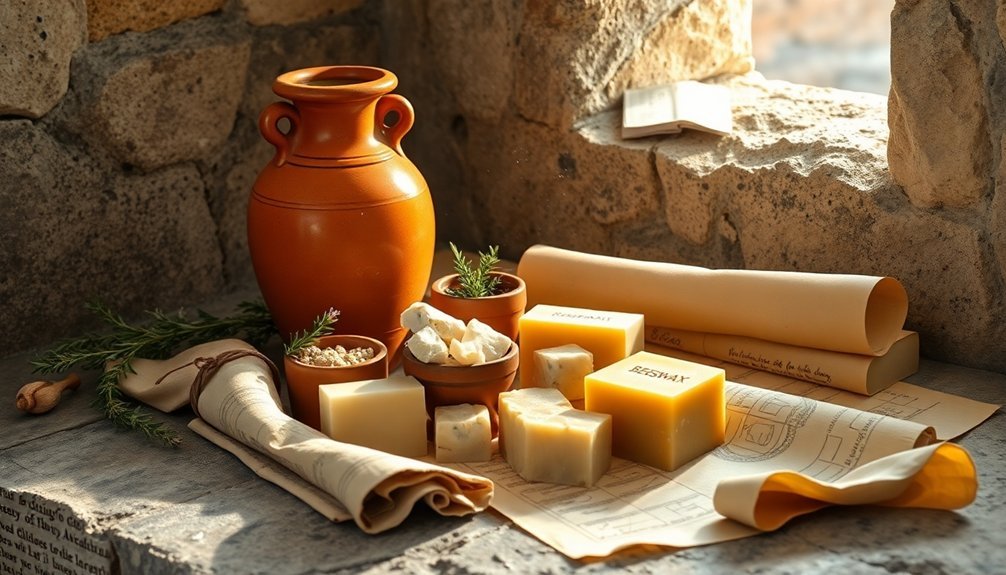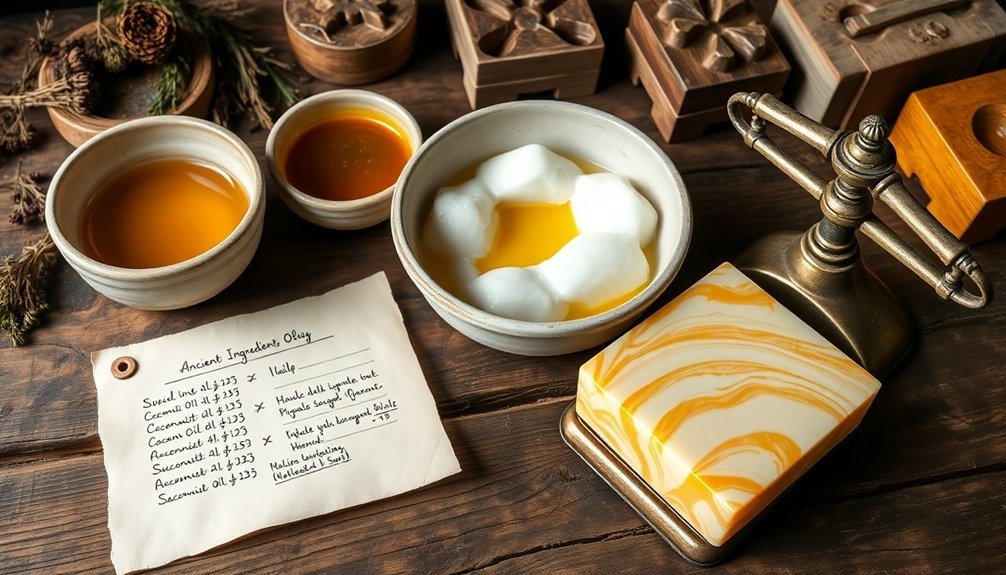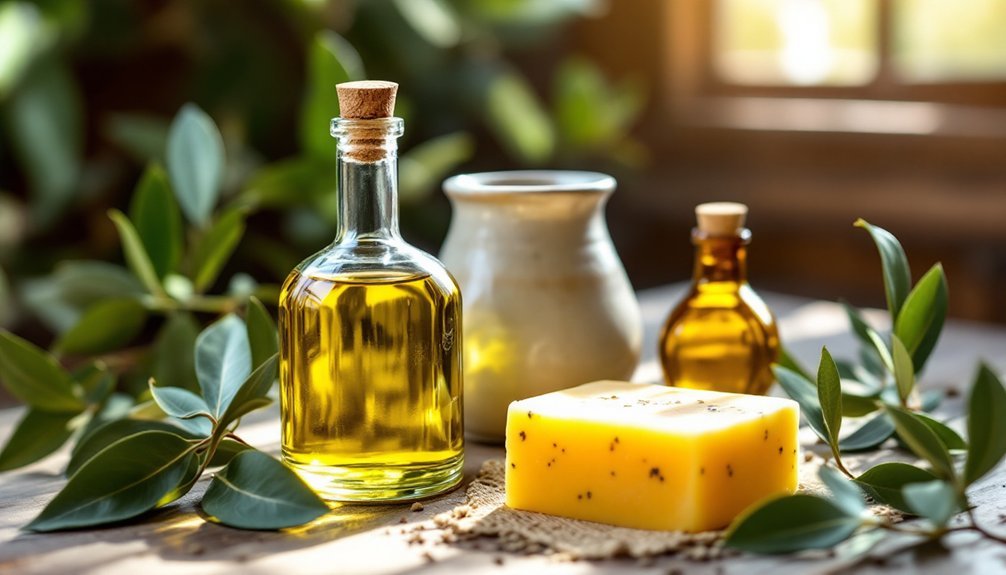Ancient soap makers mixed different oils to achieve specific benefits and overcome limitations of single-oil formulations. You'll find they balanced olive oil's moisturizing properties with coconut oil's superior lather, while adding tallow or palm oil for hardness and longevity. Their choices were heavily influenced by regional availability – Mediterranean artisans favored olive oil while Northern Europeans relied on animal fats. This strategic blending created soaps with ideal cleansing power, skin feel, and stability. The genius of their combinations continues to influence modern formulations.
The Ancient Mediterranean Olive Oil Foundation

While many modern soaps rely on synthetic ingredients, ancient Mediterranean civilizations pioneered the use of olive oil as a soap foundation nearly 5,000 years ago. Babylonians first documented this practice around 2800 BC, creating a revolutionary shift in personal hygiene.
Sumerians discovered that replacing animal fats with olive oil delivered unexpected skin benefits. This knowledge spread through trade routes, with Egyptian artisans adapting the technique for both wool preparation and body cleansing. This early soap was primarily used for cleaning wool and performing purification rituals before evolving into personal care products.
Romans, though not soap enthusiasts, recognized olive oil's skincare potential, using it with sand for exfoliation. The Mediterranean's abundant olive groves guaranteed this versatile oil remained central to soap production.
The tradition culminated in specialized regional varieties like Spain's gentle Castile soap, prized for its moisturizing properties.
Tallow and Lard: Animal Fats in Historical Recipes
Resourceful ancient soap makers turned to animal fats long before olive oil became popular, with tallow and lard serving as foundational ingredients in their earliest formulations. These animal byproducts were readily available and cost-effective, making them practical choices for soap production across ancient Greece and Rome. The Sumerians were among the first civilizations to discover the cleansing properties of tallow soap thousands of years ago.
You'll find that tallow provided exceptional stability in soap, contributing to hardness and longevity that vegetable oils couldn't match. The traditional method involved rendering fat, combining it with lye, and boiling the mixture to create a durable soap base.
Beyond cleansing, these animal-fat soaps offered medicinal benefits—their natural antibacterial and anti-inflammatory properties treated skin conditions like ringworm and scabies throughout the Middle Ages. The fats' versatility extended beyond soap to waterproofing, candle-making, and even lighting, as tallow burned efficiently in oil lamps and torches.
Regional Availability and Its Impact on Oil Selection

You'll notice stark differences between Mediterranean soap recipes rich in olive oil and Northern European formulations that relied heavily on animal fats.
Colonial trade routes transformed local soap making traditions by introducing exotic oils like palm and coconut to regions where they couldn't be cultivated naturally.
The dominance of locally available agricultural products ultimately shaped distinctive regional soap varieties, with soap makers adapting their techniques to whatever oils their environment readily provided. Soap makers carefully selected oils based on their unique fatty acid profiles, which determined the final soap's hardness, lathering ability, and moisturizing properties.
Mediterranean vs. Northern Recipes
Throughout the ancient world, soap recipes varied dramatically based on regional availability of oils and fats. The Mediterranean's abundant olive groves provided a consistent source of olive oil, making it the primary ingredient in southern soap-making traditions. When you examine Northern European recipes, you'll find animal fats like tallow dominated instead. The traditional Savon de Marseille production method utilized the region's extensive olive oil resources combined with alkaline ash from Mediterranean Sea plants.
| Region | Primary Oil | Properties | Cultural Product |
|---|---|---|---|
| Mediterranean | Olive Oil | Moisturizing, gentle | Savon de Marseille |
| Spain | Olive Oil | Antioxidant-rich | Castile Soap |
| Syria | Olive & Laurel Oil | Healing | Aleppo Soap |
| Northern Europe | Animal Tallow | Long-lasting, firm | Tallow Soap |
These regional differences weren't just about availability—they shaped entire soap-making traditions that continue to influence modern formulations. Mediterranean soaps remain prized for their skin benefits, while Northern recipes were valued for durability in harsher climates.
Colonial Trade Effects
While regional availability shaped traditional soap recipes, the expansion of colonial trade networks in the 16th-19th centuries dramatically altered the oils available to soap makers worldwide.
Colonial powers established new trade routes that introduced palm oil from West Africa to European markets by the 1870s. You'll notice this shifted production away from animal fats toward vegetable alternatives, particularly in industrial settings.
Marseille and Savona emerged as soap-making powerhouses, blending local olive oils with imported varieties.
This period also witnessed significant agricultural expansion, with massive oil palm plantations developed in Southeast Asia after WWII. Unfortunately, these plantations often displaced indigenous communities.
The technical innovations in processing that followed allowed soap makers to create more consistent products with enhanced lathering properties, forever changing traditional recipes across continents. Colonial soap makers typically used animal fat (lard) from butchered livestock as their primary ingredient, mixed with lye water derived from hardwood ashes.
Local Agriculture Dominance
Before colonial trade routes expanded global access to oils, local agriculture dominated soap-making practices in communities worldwide. You'd find soap recipes perfectly tailored to utilize whatever oils thrived in the local climate and soil conditions.
Soap makers adapted to their immediate surroundings in several key ways:
- Adjusting formulations seasonally based on oil availability and harvest cycles
- Utilizing crops that farmers were already growing for food, minimizing waste
- Developing specialized techniques for extracting oils from native plants
- Building community knowledge networks to share successful oil combinations
This regional dependence created distinct soap-making traditions that reflected local agricultural patterns. Similar to how researchers evaluate model outputs in structured formats, ancient communities systematically documented effective oil combinations for soap making.
Farmers' crop rotation practices directly influenced oil selection, while communities developed preferences based on what grew abundantly in their region, creating unique soap identities tied to specific geographic areas.
Balancing Properties: The Science Behind Blending Oils

When you blend oils for soap making, you're strategically combining different fatty acid profiles to achieve an ideal balance of properties.
The shorter-chain fatty acids in coconut oil produce robust lather and cleansing power, while the longer-chain acids in olive oil contribute moisture retention and mildness.
This careful balancing act determines whether your final soap will be hard or soft, lathering or creamy, and helps you create formulations tailored to specific skin needs. Ancient civilizations such as Babylonians understood that combining various oils with alkali created more effective cleansing products for hygiene purposes.
Fatty Acid Composition
Four primary categories of fatty acids form the foundation of soap making science.
Ancient soap makers intuitively understood what modern chemistry now explains: different oils contribute unique properties through their fatty acid profiles. When you blend oils in your soap recipe, you're actually balancing these fatty acids to create the perfect bar.
- Lauric and myristic acids (from coconut oil) provide hardness and cleansing power but can be drying if overused.
- Palmitic and stearic acids (abundant in palm oil and animal fats) create firmness and stable lather.
- Oleic acid (high in olive oil) delivers moisturizing properties and mild cleansing. The bent carbon chains in oleic acid are what make this fatty acid liquid at room temperature, contributing to softer, more moisturizing soap qualities.
- Linoleic and linolenic acids (found in sunflower oil) enhance conditioning effects and skin-nourishing benefits.
Hardness Versus Lather
The ancient art of soap making revolves around a fundamental tension between hardness and lather. You'll find this balance at the heart of every successful soap recipe throughout history.
Ancient artisans discovered that palm kernel oil created hard, long-lasting bars, while coconut oil produced luxurious, abundant lather. By blending these oils, you're not just combining ingredients—you're orchestrating properties.
Mediterranean soap makers prized olive oil for its mild, moisturizing qualities, while tropical regions favored palm oil's stability. The alkali strength further complicated this balance, requiring adjustments to oil ratios for ideal saponification. This careful formulation reflects the ancient wisdom prioritizing natural ingredients that varied across civilizations based on local availability.
You can see these same principles at work today, though modern soap makers now consider sustainability alongside traditional concerns of durability and cleansing power.
Essential Oil Aromatics in Traditional Formulations
Ancient soap makers carefully selected essential oils not just for their pleasing aromas but for their multifaceted benefits in traditional formulations.
You can see this tradition dating back to Babylonian and Egyptian civilizations, who incorporated oils like frankincense and myrrh for both spiritual and medicinal purposes.
The development of distillation by Persian alchemists in the 11th century revolutionized how you could extract and use these precious oils.
When selecting oils for your soap, consider:
- Therapeutic value (tea tree for acne, chamomile for inflammation)
- Durability through saponification
- Complementary blending potential
- Natural preservative qualities
Unlike synthetic fragrances that might cause soap to seize, essential oils harmonize with the saponification process.
While they may cost more, they provide authenticity that aligns with traditional soap making's holistic approach.
The choice of essential oils over synthetic alternatives allowed ancient soap makers to create products where the purity of essence contributed significantly to both effectiveness and aromatic quality.
Calculating the Perfect Oil Ratios for Hardness and Lather

Mastering the perfect oil ratio stands at the heart of successful soap making, transforming your creations from mere cleansers into luxurious skin treatments. The classic 34/33/33 blend of olive, coconut, and palm oils provides an excellent starting point for beginners. Understanding your total oil amount before formulating your recipe will ensure proper mould filling and soap consistency.
| Oil Type | Properties | Best For | Percentage |
|---|---|---|---|
| Coconut | Hard, cleansing | Strong lather | 25-33% |
| Olive | Soft, moisturizing | Gentle bars | 30-40% |
| Palm | Hard, stable | Bar firmness | 25-33% |
| Castor | Conditioning | Lather boost | 5-10% |
For best results, document your exact measurements. You'll want to balance hard oils for firmness with soft oils for moisture. Consider superfatting your recipe to retain beneficial properties. As you gain experience, you can experiment with specialty oils like shea butter for enhanced benefits.
Sustainability Practices in Historical Soap Making
Long before modern environmental concerns emerged, soap makers across ancient civilizations inadvertently practiced sustainability through necessity and resource limitations. Their methods reflected an intuitive understanding of efficient resource use that we're now rediscovering.
- Local Sourcing: Ancient artisans used ingredients available within their immediate environment, reducing transportation impacts and supporting regional economies.
- Minimal Waste: Historical soap production generated notably less waste than modern methods, with biodegradable ingredients returning to natural cycles.
- Renewable Materials: Plant-based oils and naturally occurring alkaline substances formed the foundation of sustainable soap recipes. Unlike traditional commercial soaps containing synthetic fragrances, ancient soap makers relied on natural additives for their aromatic and medicinal properties.
- Multipurpose Production: Soap making often integrated with other industries, using byproducts like tallow from meat production or ash from hearth fires.
You'll find these ancient practices remarkably aligned with today's circular economy principles, demonstrating sustainability's deep historical roots.
Frequently Asked Questions
Did Ancient Soap Makers Use Specialized Tools for Mixing Oils?
Ancient soapmakers didn't use highly specialized tools. You'll find they primarily used basic implements like wooden stirrers, stone grinders, and clay vessels over open fires until more refined methods emerged with European guilds and the Industrial Revolution.
How Long Did Traditional Soap Need to Cure?
You'll find traditional soap curing wasn't precisely timed. Ancient soap makers focused on dryness rather than specific periods. Today's standard of 4-6 weeks wasn't formalized then—they simply waited until soap hardened completely.
Were There Religious or Cultural Restrictions on Certain Oils?
You'll find limited historical evidence of religious restrictions on soap-making oils. Cultural preferences certainly existed, but communities typically followed traditional recipes based on local availability rather than strict religious prohibitions.
How Did Soap Makers Test Their Finished Products?
You'd test soap by floating an egg to check lye strength, performing the feather dissolution test, visually inspecting for saponification, or trying it on fabrics to evaluate its cleaning power.
Did Seasonal Temperature Changes Affect Oil Selection?
Yes, you'd adapt your oil selection seasonally. You'll choose harder oils like coconut in summer heat to prevent melting, while opting for more moisturizing olive oil during winter's dry conditions.
In Summary
You've discovered the clever wisdom behind ancient soap makers' oil blending practices. They weren't just mixing ingredients randomly—they're carefully balancing properties for peak hardness, cleansing power, and lather. By combining locally available resources like olive oil, animal fats, and aromatic botanicals, they've created sustainable formulations that worked with their environment. Their calculated approach to oil ratios shows you're part of a long tradition of practical chemistry in everyday life.





Leave a Reply